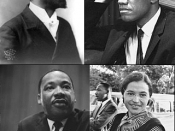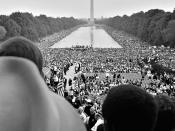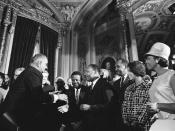"Indeed, it is the theme of paradox that best describes the postwar era - diversity in the face of uniformity, the creation of close-knit communities despite massive mobility, changes in sex roles occurring in the face of the 'feminine mystique,' the emergence of cultural rebels in the midst of chilling conformity" (Chafe, p.144). All the ideals thought of in the 40's became real in the post-war era due to the search for new identities. The 50's brought forth many new ideas and dreams such as families in suburbia's where the thought of living the "good life" often prevailed. During this time of cultural expression, frustrated suppressed groups of minorities were given no or little economic mobility, which gave birth to the American Civil Rights Movement. Social reform and activism due to the post-war effects created many more ideas causing the country to search for new ideals. In looking at Chafe's The Unfinished Journey chapters four, five, and six and chapter four in Griffith/Bakers Major Problems in American History Since 1945, we will consider the idea the "paradox of change," and find that this era was a huge turning point for the United States allowing freedom and equality to prevail.
The ideas of the American Dream were created allowing one to be in charge of his own destiny, working for their sought after dreams.
After returning from the war there was a dilemma as to whether or not women would still have their jobs as men came back. Although the number of women employed remained virtually the same, their jobs paid far lower wages and offered far less status and importance. After a few years people valued women working differently believing that, "'...it's their duty to work in times like the present, but that unlike men, they should stay meekly...


